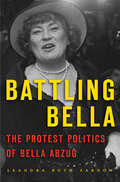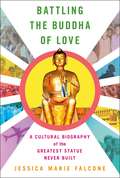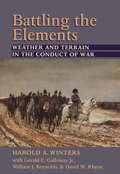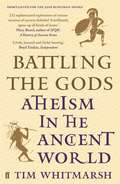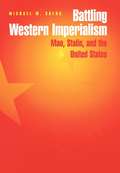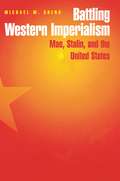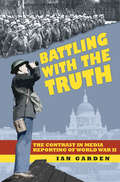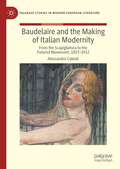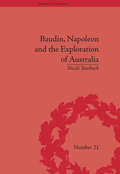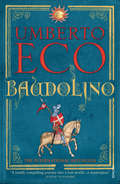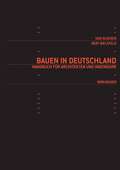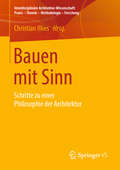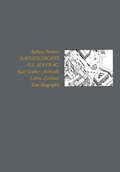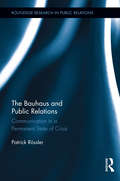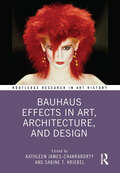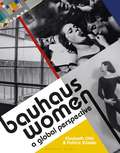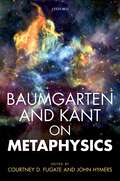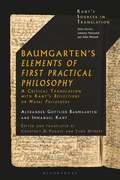- Table View
- List View
Battling Bella: The Protest Politics of Bella Abzug
by Leandra Ruth ZarnowLeandra Ruth Zarnow tells the inspiring and timely story of Bella Abzug, a New York politician who brought the passion and ideals of 1960s protest movements to Congress. Abzug promoted feminism, privacy protections, gay rights, and human rights. Her efforts shifted the political center, until more conservative forces won back the Democratic Party.
Battling the Buddha of Love: A Cultural Biography of the Greatest Statue Never Built
by Jessica Marie FalconeBattling the Buddha of Love is a work of advocacy anthropology that explores the controversial plans and practices of the Maitreya Project, a transnational Buddhist organization, as it sought to build the "world's tallest statue" as a multi-million-dollar "gift" to India. Hoping to forcibly acquire 750 acres of occupied land for the statue park in the Kushinagar area of Uttar Pradesh, the Buddhist statue planners ran into obstacle after obstacle, including a full-scale grassroots resistance movement of Indian farmers working to "Save the Land."Falcone sheds light on the aspirations, values, and practices of both the Buddhists who worked to construct the statue, as well as the Indian farmer-activists who tirelessly protested against the Maitreya Project. Because the majority of the supporters of the Maitreya Project statue are converts to Tibetan Buddhism, individuals Falcone terms "non-heritage" practitioners, she focuses on the spectacular collision of cultural values between small agriculturalists in rural India and transnational Buddhists hailing from Portland to Pretoria. She asks how could a transnational Buddhist organization committed to compassionate practice blithely create so much suffering for impoverished rural Indians.Falcone depicts the cultural logics at work on both sides of the controversy, and through her examination of these logics she reveals the divergent, competing visions of Kushinagar's potential futures. Battling the Buddha of Love traces power, faith, and hope through the axes of globalization, transnational religion, and rural grassroots activism in South Asia, showing the unintended local consequences of an international spiritual development project.
Battling the Elements: Weather and Terrain in the Conduct of War
by Harold A. WintersThroughout history, from Kublai Khan's attempted invasions of Japan to Rommel's desert warfare, military operations have succeeded or failed on the ability of commanders to incorporate environmental conditions into their tactics. In Battling the Elements, geographer Harold A. Winters and former U.S. Army officers Gerald E. Galloway Jr., William J. Reynolds, and David W. Rhyne, examine the connections between major battles in world history and their geographic components, revealing what role factors such as weather, climate, terrain, soil, and vegetation have played in combat. Each chapter offers a detailed and engaging explanation of a specific environmental factor and then looks at several battles that highlight its effects on military operations. As this cogent analysis of geography and war makes clear, those who know more about the shape, nature, and variability of battleground conditions will always have a better understanding of the nature of combat and at least one significant advantage over a less knowledgeable enemy.
Battling the Gods: Atheism in the Ancient World
by Tim WhitmarshHow new is atheism?In Battling the Gods, Tim Whitmarsh journeys into the ancient Mediterranean to recover the stories of those who first refused the divinities.Long before the Enlightenment sowed the seeds of disbelief in a deeply Christian Europe, atheism was a matter of serious public debate in the Greek world. But history is written by those who prevail, and the Age of Faith mostly suppressed the lively free-thinking voices of antiquity.Tim Whitmarsh brings to life the fascinating ideas of Diagoras of Melos, perhaps the first self-professed atheist; Democritus, the first materialist; and Epicurus and his followers. He shows how the early Christians came to define themselves against atheism, and so suppress the philosophy of disbelief.Battling the Gods is the first book on the origins of the secular values at the heart of the modern state. Authoritative and bold, provocative and humane, it reveals how atheism and doubt, far from being modern phenomena, have intrigued the human imagination for thousands of years.
Battling Western Imperialism: Mao, Stalin, and the United States (PDF)
by Michael M. ShengOne of the central issues in the study of the Chinese Communist Party and its foreign policy is its relations with Moscow. Was the CCP a Chinese nationalist party antagonistic to an intrusive Soviet Union or was it rather an internationalist party with ideological-political and strategic-military ties to Moscow, faithfully adhering to Marxist-Leninist principles as well as to Stalin's policy advice? For the past two decades a number of historians have argued that the CCP was a nationalist movement and that the United States missed its opportunity to establish friendly relations because U.S. leaders were blinded by fears of an international Communist threat. In his provocative book, Michael Sheng strongly challenges this position. On the basis of extensive new information obtained from recently available Chinese sources, Sheng demonstrates that the foreign policy of the CCP under Mao Zedong did, in fact, follow the directions recommended by Joseph Stalin. Sheng reveals that Mao and Stalin were in frequent and direct contact by radio and by correspondence, beginning in 1936, and that Mao consistently acted on Stalin's advice. Battling Western Imperialism analyzes the CCP's relations with both the Soviet Union and the United States and provides conclusive evidence that there was no "lost opportunity" for the U.S. in China. He shows that the CCP viewed the United States as a hostile capitalist power that opposed its revolutionary aims. The author has drawn on an unprecedented collection of Chinese-language materials to make a powerful new argument.
Battling Western Imperialism: Mao, Stalin, and the United States
by Michael M. ShengOne of the central issues in the study of the Chinese Communist Party and its foreign policy is its relations with Moscow. Was the CCP a Chinese nationalist party antagonistic to an intrusive Soviet Union or was it rather an internationalist party with ideological-political and strategic-military ties to Moscow, faithfully adhering to Marxist-Leninist principles as well as to Stalin's policy advice? For the past two decades a number of historians have argued that the CCP was a nationalist movement and that the United States missed its opportunity to establish friendly relations because U.S. leaders were blinded by fears of an international Communist threat. In his provocative book, Michael Sheng strongly challenges this position. On the basis of extensive new information obtained from recently available Chinese sources, Sheng demonstrates that the foreign policy of the CCP under Mao Zedong did, in fact, follow the directions recommended by Joseph Stalin. Sheng reveals that Mao and Stalin were in frequent and direct contact by radio and by correspondence, beginning in 1936, and that Mao consistently acted on Stalin's advice. Battling Western Imperialism analyzes the CCP's relations with both the Soviet Union and the United States and provides conclusive evidence that there was no "lost opportunity" for the U.S. in China. He shows that the CCP viewed the United States as a hostile capitalist power that opposed its revolutionary aims. The author has drawn on an unprecedented collection of Chinese-language materials to make a powerful new argument.
Battling With the Truth: The Contrast in the Media Reporting of World War II
by Ian Garden‘Think of the press as a great keyboard on which the government can play.’ – Joseph Goebbels, Reich Minister of Public Enlightenment and Propaganda Dunkirk, Stalingrad, the Dieppe Raid: there were many bloody and gruesome conflicts fought during the Second World War, yet there was one vital and aggressive battle in which no blood was directly shed – that of the warring nations’ battle with the truth. In Battling With the Truth (a follow-up to The Third Reich’s Celluloid War) Ian Garden offers fascinating insights into the ways by which both the Axis and Allies manipulated military and political facts for their own ends. By analysing key incidents and contemporary sources from both British and German perspectives, he reveals how essential information was concealed from the public. Asking how both sides could have believed they were fighting a just war, Garden exposes the extent to which their peoples were told downright lies or fed very carefully worded versions of the truth. Often these ‘versions’ gave completely false impressions of the success or failure of missions – even whole campaigns. Ultimately, Battling With the Truth demonstrates that almost nothing about war is as clear-cut as the reporting at the time makes out. From the past, we can learn valuable lessons about the continuing potential for media manipulation and political misinformation – especially during wartime.
Baudelaire and the Making of Italian Modernity: From the Scapigliatura to the Futurist Movement, 1857-1912 (Palgrave Studies in Modern European Literature)
by Alessandro CabiatiThis book establishes the role of French writer Charles Baudelaire in the formation of paradigms of modernity in Italian poetry between 1857, the year of publication of Baudelaire’s highly influential collection Les Fleurs du Mal, and 1912, when the first anthology of Futurist poetry, I poeti futuristi, was published in Milan. It focuses primarily on Baudelaire’s influence on the poetry of the Scapigliatura, a long-underrated movement which in the 1860s introduced a thematic and formal modernity into Italian literature, paving the way for Futurism and the twentieth-century avant-garde. This monograph also investigates Baudelaire’s and the Scapigliatura’s interrelated impacts on early Futurist poetry, demonstrating that Futurist poets turned to the works of Baudelaire and the Scapigliatura for inspiration on themes that were considered as distinctly unpoetic – and therefore modern – such as medical-anatomical examination, technological transformation, and abnormal sensuality.
Baudin, Napoleon and the Exploration of Australia (Empires in Perspective)
by Nicole StarbuckThis is the first in-depth study of the sojourn in Sydney made by Nicolas Baudin’s scientific expedition to Australia in 1802. Starbuck focuses on the reconstruction of the voyage during the expedition’s stay in colonial Sydney and how this sheds new light on our understanding of French society, politics and science in the era of Bonaparte.
Baudin, Napoleon and the Exploration of Australia (Empires in Perspective #21)
by Nicole StarbuckThis is the first in-depth study of the sojourn in Sydney made by Nicolas Baudin’s scientific expedition to Australia in 1802. Starbuck focuses on the reconstruction of the voyage during the expedition’s stay in colonial Sydney and how this sheds new light on our understanding of French society, politics and science in the era of Bonaparte.
Baudolino (Booket/columna Ser. #Vol. 28)
by Umberto EcoAn extraordinary epic, brilliantly-imagined, new novel from a world-class writer and author of The Name of the Rose. Discover the Middle Ages with Baudolino - a wondrous, dazzling, beguiling tale of history, myth and invention. It is 1204, and Constantinople is being sacked and burned by the knights of the fourth Crusade. Amid the carnage and confusion Baudolino saves a Byzantine historian and high court official from certain death at the hands of the crusading warriors, and proceeds to tell his own fantastical story.
Bauen in Deutschland: Handbuch für Architekten und Ingenieure (Bauen in Europa (u.China))
by Udo Blecken Bert BielefeldDieses Handbuch bietet einen strukturierten Überblick über die Arbeit von Architekten und Ingenieuren in Deutschland: von der Auftragsbeschaffung, über die Planung, bis hin zur Bauausführung und Bauabnahme. Durch die anschauliche Vermittlung des rechtlichen und wirtschaftlichen Umfelds sowie praktischer Hilfestellung stellt "Bauen in Deutschland" eine wertvolle Unterstützung des Berufsalltags dar.
Bauen mit Sinn: Schritte zu einer Philosophie der Architektur (Interdisziplinäre Architektur-Wissenschaft: Praxis – Theorie – Methodologie – Forschung)
by Christian IlliesArchitektur ist mehr als die technisch-funktionale Lösung eines praktischen Problems. In Bauwerken drückt sich immer auch ein Weltverhältnis aus - und macht zugleich ein bleibendes Sinn-Angebot. Architektur ist deswegen ein Anstoß, manchmal auch ein Apell, über sehr unterschiedliche Fragen nachzudenken, sich zu ihnen zu verhalten und sich dabei geistig zu verorten.In diesem Buch begegnen sich eine Vielfalt der Deutungs- und Annäherungsmöglichkeiten durch Vertreter unterschiedlicher Kultur- und Geisteswissenschaften. Die Eigenart der Wahrnehmungen und unterschiedlichen methodischen Herangehensweisen kommen so in ein Gespräch. Es soll zu einem besseres Verstehen, aber auch Bewerten führen. Denn wenn Bauwerke Sinn-Angebote machen, lassen sich diese auch beurteilen, da sie Ideale und mögliche Lebensweisen ausdrücken machen, die nicht alle gleichwertig sind. Der InhaltSchritte zu einer Philosophie der Architektur · Die Struktur des Raumes und die urbane Gemeinschaft · Das ‚Architektonische‘· Zur Aufgabe einer Philosophie des Bauwerks · Geometrische Muster zwischen frühneuzeitlicher Utopie und russischer Avantgarde · Moderne oder historisierende Architektur in der alten Stadt · Die Architektur des Heiligen · Meta Sudans, oder: Akustik und Geruch im antiken Rom -· Die Verallgemeinerung des Besonderen. Die Dresdner Frauenkirche und der gegenwärtige Rekonstruktionsfuror · Die Architektur der Schöpferischen Zerstörung · Architektur und Bild · Stadtbaukunst · Was ist gute Architektur? · Über Wahrheit und Lüge im architektonischen Sinn · Rekonstruktion in historischer und aktueller Perspektive · Wie gefährlich sind Rekonstruktionen? · Wie sollen wir bauen?Der HerausgeberDr. Christian Illies ist Professor für Philosophie an der Universität Bamberg.
Baugeschichte als Auftrag: Karl Gruber: Architekt, Lehrer, Zeichner Eine Biographie
by Andreas RomeroThe Bauhaus and Public Relations: Communication in a Permanent State of Crisis (Routledge Research in Public Relations)
by Patrick RösslerThis innovative study considers one of the most important art and design movements of the 20th century, the Bauhaus, in conjunction with current research in public relations and organizational communication, elaborating on the mechanisms of internal and external communication available to influence the stakeholders in politics, society, industry, and the art world. In a movement where a substantial share of productivity ran in measures to highlight the public value of the institution funded by the taxpayer, the directors, and other persons in charge, the Bauhaus developed comprehensive strategies to communicate their messages to a variety of target groups such as politicians and economic leaders, intellectuals and other artists, current and prospective students, and the general public. To achieve this goal, the Bauhaus anticipated many instruments of modern public relations and corporate communications, including press releases, staging of events, media publications, community building, lobbying, and the creation of nationwide public presence. Rössler argues that as an organization, the Bauhaus cultivated corporate behavior and, most prominently, a corporate design which unfolded revolutionary power. The basic achievements of new typography (a label coined at the Bauhaus) determine visual communication to this day, while the Bauhaus moved from an institutional organization to a community. Beginning with an overview of the Bauhaus’ corporate identity and a close examination of the respective directors’ roles for internal and external communication, this book visits exhibitions, events, and the media attention they evoked in newspapers and contemporary periodicals, along with media products designed at the Bauhaus such as magazines, books, and bank notes.
The Bauhaus and Public Relations: Communication in a Permanent State of Crisis (Routledge Research in Public Relations)
by Patrick RösslerThis innovative study considers one of the most important art and design movements of the 20th century, the Bauhaus, in conjunction with current research in public relations and organizational communication, elaborating on the mechanisms of internal and external communication available to influence the stakeholders in politics, society, industry, and the art world. In a movement where a substantial share of productivity ran in measures to highlight the public value of the institution funded by the taxpayer, the directors, and other persons in charge, the Bauhaus developed comprehensive strategies to communicate their messages to a variety of target groups such as politicians and economic leaders, intellectuals and other artists, current and prospective students, and the general public. To achieve this goal, the Bauhaus anticipated many instruments of modern public relations and corporate communications, including press releases, staging of events, media publications, community building, lobbying, and the creation of nationwide public presence. Rössler argues that as an organization, the Bauhaus cultivated corporate behavior and, most prominently, a corporate design which unfolded revolutionary power. The basic achievements of new typography (a label coined at the Bauhaus) determine visual communication to this day, while the Bauhaus moved from an institutional organization to a community. Beginning with an overview of the Bauhaus’ corporate identity and a close examination of the respective directors’ roles for internal and external communication, this book visits exhibitions, events, and the media attention they evoked in newspapers and contemporary periodicals, along with media products designed at the Bauhaus such as magazines, books, and bank notes.
Bauhaus Effects in Art, Architecture, and Design (Routledge Research in Art History)
by Kathleen James-ChakrabortyBringing together an international team of scholars, this book offers new perspectives on the impact that the Bauhaus and its teaching had on a wide range of artistic practices. Three of the fields in which the Bauhaus generated immediately transformative effects were housing, typography, and photography. Contributors go further to chart the surprising relation of the school to contemporary developments in hairstyling and shop window display in unprecedented detail. New scholarship has detailed the degree to which Bauhaus faculty and students set off around the world, but it has seldom paid attention to its impact in communist East Germany or in countries like Ireland where no Bauhäusler settled. This wide-ranging collection makes clear that a century after its founding, many new stories remain to be told about the influence of the twentieth century’s most innovative arts institution. The book will be of interest to scholars working in art history, design history, photography, and architectural history.
Bauhaus Effects in Art, Architecture, and Design (Routledge Research in Art History)
by Kathleen James-Chakraborty Sabine T. KriebelBringing together an international team of scholars, this book offers new perspectives on the impact that the Bauhaus and its teaching had on a wide range of artistic practices. Three of the fields in which the Bauhaus generated immediately transformative effects were housing, typography, and photography. Contributors go further to chart the surprising relation of the school to contemporary developments in hairstyling and shop window display in unprecedented detail. New scholarship has detailed the degree to which Bauhaus faculty and students set off around the world, but it has seldom paid attention to its impact in communist East Germany or in countries like Ireland where no Bauhäusler settled. This wide-ranging collection makes clear that a century after its founding, many new stories remain to be told about the influence of the twentieth century’s most innovative arts institution. The book will be of interest to scholars working in art history, design history, photography, and architectural history.
Bauhaus Women: A Global Perspective
by Elizabeth Otto RösslerForty five key women of the Bauhaus movement.Bauhaus Women: A Global Perspective reclaims the other half of Bauhaus history, yielding a new understanding of the radical experiments in art and life undertaken at the Bauhaus and the innovations that continue to resonate with viewers around the world today. The story of the Bauhaus has usually been kept narrow, localized to its original time and place and associated with only a few famous men such as Walter Gropius, Marcel Breuer, Paul Klee, Wassily Kandinsky, and László Moholy-Nagy. Bauhaus Women: A Global Perspective bursts the bounds of this slim history by revealing fresh Bauhaus faces: Forty-five Bauhaus women unjustifiably forgotten by most history books. This book also widens the lens to reveal how the Bauhaus drew women from many parts of Europe and beyond, and how, through these cosmopolitan female designers, artists, and architects, it sent the Bauhaus message out into the world and to a global audience.
Bauhaus Women: A Global Perspective
by Elizabeth Otto RösslerForty five key women of the Bauhaus movement.Bauhaus Women: A Global Perspective reclaims the other half of Bauhaus history, yielding a new understanding of the radical experiments in art and life undertaken at the Bauhaus and the innovations that continue to resonate with viewers around the world today. The story of the Bauhaus has usually been kept narrow, localized to its original time and place and associated with only a few famous men such as Walter Gropius, Marcel Breuer, Paul Klee, Wassily Kandinsky, and László Moholy-Nagy. Bauhaus Women: A Global Perspective bursts the bounds of this slim history by revealing fresh Bauhaus faces: Forty-five Bauhaus women unjustifiably forgotten by most history books. This book also widens the lens to reveal how the Bauhaus drew women from many parts of Europe and beyond, and how, through these cosmopolitan female designers, artists, and architects, it sent the Bauhaus message out into the world and to a global audience.
Baumgarten and Kant on Metaphysics
by John Hymers Courtney D. FugateBaumgarten and Kant on Metaphysics explores the metaphysics of Alexander Gottlieb Baumgarten (17141762) and its decisive influence on Immanuel Kant. For over a century, scholars have recognized the significance of Baumgarten's Metaphysics, both because of its impact on Kant's intellectual development, and because of the way it fundamentally informed the work of generations of German philosophers, including Moses Mendelssohn, Thomas Abbt, Johann Gottfried Herder, Solomon Maimon, Johann August Eberhard, and arguably even Georg Friedrich Hegel. However, Baumgarten's Metaphysics has only recently become available in reliable German and English translations; as such, many scholars have been excluded from the discussion and the significance of Baumgarten's work has remained largely unexplored. Thus with the appearance of these translations, interest in Baumgarten's work has surged. This collection provides an anchor for this emerging discussion by presenting chapters by some of the scholars most responsible for Baumgarten's current reputation, together with some of the best young scholars in this emerging field.
Baumgarten and Kant on Metaphysics
Baumgarten and Kant on Metaphysics explores the metaphysics of Alexander Gottlieb Baumgarten (17141762) and its decisive influence on Immanuel Kant. For over a century, scholars have recognized the significance of Baumgarten's Metaphysics, both because of its impact on Kant's intellectual development, and because of the way it fundamentally informed the work of generations of German philosophers, including Moses Mendelssohn, Thomas Abbt, Johann Gottfried Herder, Solomon Maimon, Johann August Eberhard, and arguably even Georg Friedrich Hegel. However, Baumgarten's Metaphysics has only recently become available in reliable German and English translations; as such, many scholars have been excluded from the discussion and the significance of Baumgarten's work has remained largely unexplored. Thus with the appearance of these translations, interest in Baumgarten's work has surged. This collection provides an anchor for this emerging discussion by presenting chapters by some of the scholars most responsible for Baumgarten's current reputation, together with some of the best young scholars in this emerging field.
Baumgarten and Kant on the Foundations of Practical Philosophy
by John Hymers Courtney D. FugateOver the last two decades, scholarship on Kant and modern German philosophy has become increasingly focused on understanding their historical roots. Central to this development is the work of Alexander Gottlieb Baumgarten (1714-62), whose textbooks profoundly influenced later generations of German philosophers. Immanuel Kant (1724-1804), in particular, lectured from Baumgarten's textbooks, including those on moral and legal philosophy, for well over thirty years. Following the recent English translation of Baumgarten's key works, this volume is the first comprehensive reappraisal of the relationship between his and Kant's thoughts on the grounding principles of moral philosophy. The chapters--all written by leading researchers who have shaped or are now reshaping the field--cover the whole range of key concepts in the foundations of practical philosophy: obligation, law, goodness, motivation, imputation, conscience, the relationship between ethics and right, and many more. Later chapters provide a comparative look at Kant's and Baumgarten's place within the wider tradition of natural law. Scholars familiar with the field will discover new perspectives on well-received findings, while newcomers will find a comprehensive introduction to the key topics and debates of current research.
Baumgarten and Kant on the Foundations of Practical Philosophy
Over the last two decades, scholarship on Kant and modern German philosophy has become increasingly focused on understanding their historical roots. Central to this development is the work of Alexander Gottlieb Baumgarten (1714-62), whose textbooks profoundly influenced later generations of German philosophers. Immanuel Kant (1724-1804), in particular, lectured from Baumgarten's textbooks, including those on moral and legal philosophy, for well over thirty years. Following the recent English translation of Baumgarten's key works, this volume is the first comprehensive reappraisal of the relationship between his and Kant's thoughts on the grounding principles of moral philosophy. The chapters--all written by leading researchers who have shaped or are now reshaping the field--cover the whole range of key concepts in the foundations of practical philosophy: obligation, law, goodness, motivation, imputation, conscience, the relationship between ethics and right, and many more. Later chapters provide a comparative look at Kant's and Baumgarten's place within the wider tradition of natural law. Scholars familiar with the field will discover new perspectives on well-received findings, while newcomers will find a comprehensive introduction to the key topics and debates of current research.
Baumgarten's Elements of First Practical Philosophy: A Critical Translation with Kant's Reflections on Moral Philosophy (Kant’s Sources in Translation)
by Alexander Gottlieb Baumgarten Immanuel KantThis book presents the first English translation of Alexander Baumgarten's Initia Philosophiae Practicae Primae, the textbook Kant used in his lectures on moral philosophy. Originally published in Latin in 1760, the Initia contains a systematic, but original version of the universal practical philosophy first articulated by Christian Wolff. In his personal copy, Kant penned hundreds of pages of notes and sketches that document his relation to this earlier tradition. Translating these extensive elucidations into English, together with Kant's notes on the text, this translation offers a complete resource to Kant's reading of the Initia. To facilitate further study, first-time translations of elucidatory passages from G. F. Meier and Wolff are also included, alongside a German-English-Latin glossary. The translators' introduction provides a biography of Baumgarten, a discussion of the importance of the Initia, its relation to Wolff's and Meier's universal practical philosophy and its role in Kant's lectures. By shedding new light on the arguments of Kant's mature works and offering insights into his pre-Critical moral thought, Elements of First Practical Philosophy reveals why Baumgarten's work is essential for understanding the background to Kant's philosophy.
